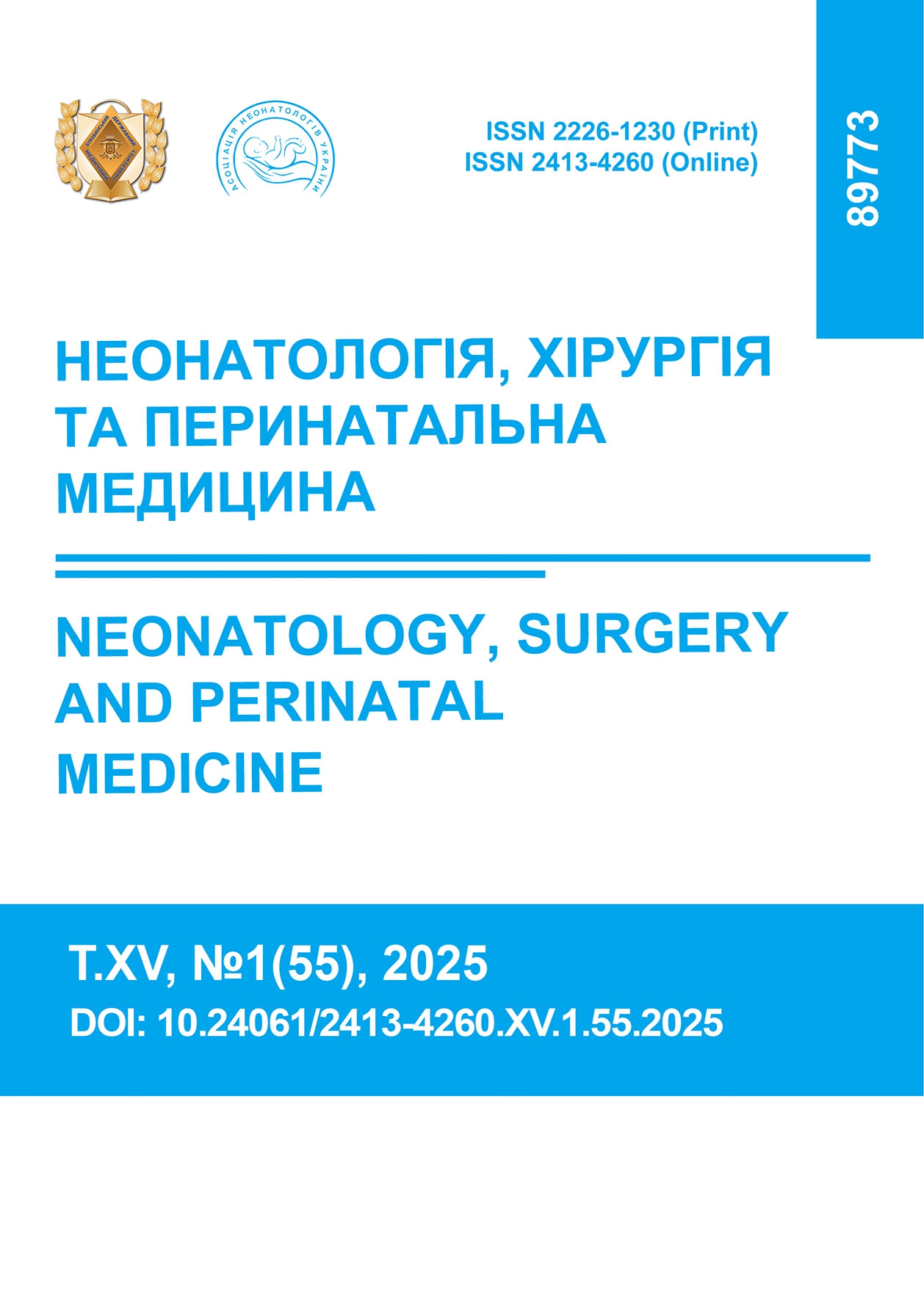ЗАСТОСУВАННЯ ПРОТИСПАЙКОВИХ ПРЕПАРАТІВ У ВАГІТНИХ ЖІНОК ПРИ ЗАЩЕМЛЕНИХ ПІСЛЯОПЕРАЦІЙНИХ ГРИЖАХ І ПРИ ГОСТРІЙ СПАЙКОВІЙ ТОНКОКИШКОВІЙ НЕПРОХАДНОСТІ
DOI:
https://doi.org/10.24061/2413-4260.XV.1.55.2025.11Ключові слова:
спайкова хвороба очеревини у вагітних жінок; гостра спайкова тонкокишкова непрохідність; препарат гіалуронової кислоти; роз’єднання спайокАнотація
Спайкова хвороба очеревини є однією зі складних і невирішених проблем хірургії. Кількість хворих постійно зростає, що обумовлено збільшенням кількості та обсягів оперативних втручань на органах черевної порожнини.
Мета – вивчити та порівняти результати лікування вагітних жінок зі спайками очеревини після невідкладних оперативних втручань, при яких проводили роз’єднання спайок і використовували препарат гіалуронової кислоти.
Матеріали і методи. За період з 2012 по 2024 рр. обстежено та проліковано 80 вагітних жінок із спайковою хворобою, які перенесли роз’єднання спайок, віком від 21 до 42 років. Хворих розподілено на наступні групи: 1) контрольна – 20 хворих, яким проведено ургентне оперативне лікування, роз’єднання спайок та консервативне лікування загальноприйнятими методами при защемлених післяопераційних грижах; 2) друга група – 20 пацієнтів, яким проведено оперативне втручання у зв’язку із защемленими вентральними грижами та роз’єднання спайок із застосуванням препарату гіалуронової кислоти; 3) третя група – 20 пацієнтів, яким проводили терміновий ентероліз без застосування препарату гіалуронової кислоти, з гострою спайковою тонкокишковою непрохідністю; 4) четверта група – 20 хворих, яким проводили терміновий ентероліз із застосуванням препарату гіалуронової кислоти, з гострою спайковою тонкокишковою непрохідністю.
Результати. У другій групі після оперативного втручання і застосування препарату гіалуронової кислоти отримані добрі найближчі та віддалені результати з терміном спостереження до 6 років. Однак у четвертої групи пацієнтів після термінового ентеролізу та застосування препарату спостерігається поліпшення найближчих результатів, але віддалені результати практично не відрізнялися від третьої групи пацієнтів.
Висновки. Доведено, що гіалуронова кислота ефективна при лікуванні спайок під час операцій у пацієнтів з післяопераційними грижами. Однак гіалуронова кислота не ефективна в екстрених операціях при гострій спайковій кишковій непрохідності. Досягти кращих результатів можливо при комплексному підході до профілактики та лікування спайкової хвороби очеревини, застосуванні сучасних і нових протиспайкових препаратів.
Посилання
Bouassida M, Laamiri G, Zribi S, Slama H, Mroua B, Sassi S, et al. Predicting Intestinal Ischaemia in Patients with Adhesive Small Bowel Obstruction: A Simple Score. World J Surg. 2020;44(5):1444-9. DOI: http://doi.org/10.1007/s00268-020-05377-6 PMID: 31925521.
Capella-Monsonís H, Kearns S, Kelly J, Zeugolis DI. Battling adhesions: from understanding to prevention. BMC Biomed Eng. 2019;1:5. DOI: http://doi.org/10.1186/s42490-019-0005-0 PMID: 32903353; PMCID: PMC7412649.
Catena F, De Simone B, Coccolini F, Di Saverio S, Sartelli M, Ansaloni L. Bowel obstruction: a narrative review for all physicians. World J Emerg Surg. 2019;14:20. DOI: http://doi.org/10.1186/s13017-019-0240-7 PMID: 31168315; PMCID: PMC6489175.
Cohen RB, Olafson SN, Krupp J, Parsikia A, Kaplan MJ, Moran B, et al. Timing of Gastrografin administration in the management of adhesive small bowel obstruction (ASBO): Does it matter? Surgery. 2021;170(2):596-602. DOI: http://doi.org/10.1016/j.surg.2021.03.008 PMID: 33836900.
Fatehi Hassanabad A, Zarzycki AN, Jeon K, Deniset JF, Fedak PWM. Post-Operative Adhesions: A Comprehensive Review of Mechanisms. Biomedicines. 2021;9(8):867. DOI: http://doi.org/10.3390/biomedicines9080867 PMID: 34440071; PMCID: PMC8389678.
Fatehi Hassanabad A, Zarzycki AN, Jeon K, Dundas JA, Vasanthan V, Deniset JF, et al. Prevention of Post-Operative Adhesions: A Comprehensive Review of Present and Emerging Strategies. Biomolecules. 2021;11(7):1027. DOI: http://doi.org/10.3390/biom11071027 PMID: 34356652; PMCID: PMC8301806.
Ferns GA, Hassanian SM, Arjmand MH. Hyperglycaemia and the risk of post-surgical adhesion. Arch Physiol Biochem. 2022;128(6):1467-73. DOI: http://doi.org/10.1080/13813455.2020.1776330 PMID: 32536284.
Figueroa LM, Escobar G, Osorno J, Acuña M, Solarte J. Peritonealized urachal remnant and obstructive congenital peritoneal band. A case report. Cir Pediatr. 2022;35(1):46-9. DOI: http://doi.org/10.54847/cp.2022.01.19 PMID: 35037441.
Foster DS, Marshall CD, Gulati GS, Chinta MS, Nguyen A, Salhotra A, et al. Elucidating the fundamental fibrotic processes driving abdominal adhesion formation. Nat Commun. 2020;11(1):4061. DOI: http://doi.org/10.1038/s41467-020-17883-1 PMID: 32792541; PMCID: PMC7426428.
Fofanov OD, Didukh IM. Treatment and prevention of adhesive intestinal obstruction in children. Paediatric surgery. 2023;4(81):43-8. DOI: https://doi.org/10.15574/PS.2023.81.43
Gudiev C, Minaev S, Vasiliev V. Method of prevention of post-operative peritoneal adhesions. North Clin Istanb. 2023;10(1):33-9. DOI: http://doi.org/10.14744/nci.2022.21347 PMID: 36910438; PMCID: PMC9996661.
Gumán-Valdivia-Gómez G, Tena-Betancourt E, de Alva-Coria PM. Postoperative abdominal adhesions: pathogenesis and current preventive techniques. Cir Cir. 2019;87(6):698-703. DOI: http://doi.org/10.24875/CIRU.18000511 PMID: 31631189.
Herrick SE, Wilm B. Post-Surgical Peritoneal Scarring and Key Molecular Mechanisms. Biomolecules. 2021;11(5):692. DOI: http://doi.org/10.3390/biom11050692 PMID: 34063089; PMCID: PMC8147932.
Kang BM. Laparoscopic Adhesiolysis for Small Bowel Obstruction: Effective Alternatives or Immoderate Challenge? J Minim Invasive Surg. 2020;23(2):65-6. DOI: http://doi.org/10.7602/jmis.2020.23.2.65 PMID: 35600057; PMCID: PMC8985610.
Krämer B, Neis F, Brucker SY, Kommoss S, Andress J, Hoffmann S. Peritoneal Adhesions and their Prevention - Current Trends. Surg Technol Int. 2021;38:221-33. DOI: http://doi.org/10.52198/21.STI.38.HR1385 PMID: 33503674.
Krielen P, Stommel MWJ, Pargmae P, Bouvy ND, Bakkum EA, Ellis H, et al. Adhesion-related readmissions after open and laparoscopic surgery: a retrospective cohort study (SCAR update). Lancet. 2020;395(10217):33-41. DOI: http://doi.org/10.1016/S0140-6736(19)32636-4 PMID: 31908284.
Lee MJ, Sayers AE, Drake TM, Singh P, Bradburn M, Wilson TR, et al. Malnutrition, nutritional interventions and clinical outcomes of patients with acute small bowel obstruction: results from a national, multicentre, prospective audit. BMJ Open. 2019;9(7):e029235. DOI: http://doi.org/10.1136/bmjopen-2019-029235 PMID: 31352419; PMCID: PMC6661661.
Medvecz AJ, Dennis BM, Wang L, Lindsell CJ, Guillamondegui OD. Impact of Operative Management on Recurrence of Adhesive Small Bowel Obstruction: A Longitudinal Analysis of a Statewide Database. J Am Coll Surg. 2020;230(4):544-51.e1. DOI: http://doi.org/10.1016/j.jamcollsurg.2019.12.006 PMID: 31954815; PMCID: PMC7103552.
Melnichenko M, Kvashnina A. Pathogenetic aspects of post-surgical adhesions prevention (review of literature). J Educ Health Sport. 2020;10(5):380-93. DOI: http://dx.doi.org/10.12775/JEHS.2020.10.05.040
Mu JF, Wang Q, Wang SD, Wang C, Song JX, Jiang J, et al. Clinical factors associated with intestinal strangulating obstruction and recurrence in adhesive small bowel obstruction: A retrospective study of 288 cases. Medicine (Baltimore). 2018;97(34):e12011. DOI: http://doi.org/10.1097/MD.0000000000012011 PMID: 30142844; PMCID: PMC6112878.
Nakao E, Honda M, Takano Y, Suzuki N, Todate Y, Kawamura H, et al. Clinical Indicators to Determine the Timing of Surgery for Adhesive Small Bowel Obstruction. Am Surg. 2023;89(12):5768-74. DOI: http://doi.org/10.1177/00031348231175465 PMID: 37159935.
Okubo S, Shindoh J, Kobayashi Y, Hashimoto M. Safety of Use of a Sheet-Type Adhesion Barrier (Interceed®) During Liver Surgery. World J Surg. 2020;44(12):4214-20. DOI: http://doi.org/10.1007/s00268-020-05743-4 PMID: 32808075.
Osifo OD, Ovueni ME. Is nonoperative management of adhesive intestinal obstruction applicable to children in a resource-poor country? Afr J Paediatr Surg. 2010;7(2):66-70. DOI: http://doi.org/10.4103/0189-6725.62843 PMID: 20431212.
Paisant A, Burgmaier J, Calame P, Loison M, Molière S, Brigand C, et al. The Angers CT Score is a Risk Factor for the Failure of the Conservative Management of Adhesive Small Bowel Obstruction: A Prospective Observational Multicentric Study. World J Surg. 2023;47(4):975-84. DOI: http://doi.org/10.1007/s00268-023-06906-9 PMID: 36648518.
Sabbagh C, Mauvais F, Tuech JJ, Tresallet C, Ortega-Debalon P, Mathonnet M, et al. Impact of a procalcitonin-based algorithm on the quality of management of patients with uncomplicated adhesion-related small bowel obstruction assessed by a textbook outcome: a multicenter cluster-randomized open-label controlled trial. BMC Gastroenterol. 20222;22(1):90. DOI: http://doi.org/10.1186/s12876-022-02144-w PMID: 35236281; PMCID: PMC8889719.
Sultana T, Gwon JG, Lee BT. Thermal stimuli-responsive hyaluronic acid loaded cellulose based physical hydrogel for post-surgical de novo peritoneal adhesion prevention. Mater Sci Eng C Mater Biol Appl. 2020;110:110661. DOI: http://doi.org/10.1016/j.msec.2020.110661 PMID: 32204089.
Tanaka Y, Kaneoka Y, Maeda A, Takayama Y, Takahashi T, Kiriyama M, et al. Surgical Approach for Adhesive Small Bowel Obstruction: Analysis of Risk Factors of Treatment Failure. Indian J Surg. 2023;85:579–84. DOI: http://doi.org/10.1007/s12262-022-03518-w
Ten Broek RPG, Krielen P, Di Saverio S, Coccolini F, Biffl WL, Ansaloni L, et al. Bologna guidelines for diagnosis and management of adhesive small bowel obstruction (ASBO): 2017 update of the evidence-based guidelines from the world society of emergency surgery ASBO working group. World J Emerg Surg. 2018;13:24. DOI: http://doi.org/10.1186/s13017-018-0185-2 PMID: 29946347; PMCID: PMC6006983.
Tian Z, Xu J, Wang Y, Gao P. Recurrence After Operated Adhesive Small Bowel Obstruction: Development and Validation of a Predictive Model. J Gastrointest Surg. 2023;27(6):1216-27. DOI: http://doi.org/10.1007/s11605-023-05659-z PMID: 36988784.
Tong JWV, Lingam P, Shelat VG. Adhesive small bowel obstruction - an update. Acute Med Surg. 2020;7(1):e587. DOI: http://doi.org/10.1002/ams2.587 PMID: 33173587; PMCID: PMC7642618.
Uprak TK, Akin MI, Coskun M, Yegen C. Factors Predicting Surgical Treatment in Patients with Adhesive Small Bowel Obstruction: Retrospective Single-centre Study. J Coll Physicians Surg Pak. 2022;32(9):1127-31. DOI: http://doi.org/10.29271/jcpsp.2022.09.1127 PMID: 36089707.
van den Beukel BAW, Toneman MK, van Veelen F, van Oud-Alblas MB, van Dongen K, Stommel MWJ, et al. Elective adhesiolysis for chronic abdominal pain reduces long-term risk of adhesive small bowel obstruction. World J Emerg Surg. 2023;18(1):8. DOI: http://doi.org/10.1186/s13017-023-00477-9 PMID: 36691000; PMCID: PMC9872389.
van Veen T, Ramanathan P, Ramsey L, Dort J, Tabello D. Predictive factors for operative intervention and ideal length of non-operative trial in adhesive small bowel obstruction. Surg Endosc. 2023;37(11):8628-35. DOI: http://doi.org/10.1007/s00464-023-10282-9 PMID: 37495847.
Vernamonti JP, Lotakis DM, Hartman H, Dougherty D, Jarboe MD. Ultrasound assessment of abdominal adhesions in neonates: data over dogma for re-operative timing. Pediatr Surg Int. 2023;39(1):143. DOI: http://doi.org/10.1007/s00383-023-05430-0 PMID: 36856872.
Victory Srinivasan N, Khan AI, Mashat GD, Hazique M, Khan KI, Ramesh P, et al. Recurrence of Small Bowel Obstruction in Adults After Operative Management of Adhesive Small Bowel Obstruction: A Systematic Review. Cureus. 2022;14(9):e29141. DOI: http://doi.org/10.7759/cureus.29141 PMID: 36259040; PMCID: PMC9561403.
Zhang E, Song B, Shi Y, Zhu H, Han X, Du H, et al. Fouling-resistant zwitterionic polymers for complete prevention of postoperative adhesion. Proc Natl Acad Sci U S A. 2020;117(50):32046-55. DOI: http://doi.org/10.1073/pnas.2012491117 PMID: 33257542; PMCID: PMC7749340.
Zins M, Millet I, Taourel P. Adhesive Small Bowel Obstruction: Predictive Radiology to Improve Patient Management. Radiology. 2020;296(3):480-92. DOI: http://doi.org/10.1148/radiol.2020192234 PMID: 32692296.
##submission.downloads##
Опубліковано
Як цитувати
Номер
Розділ
Ліцензія

Ця робота ліцензується відповідно до Creative Commons Attribution 4.0 International License.
Автори, які публікуються у цьому журналі, погоджуються з наступними умовами:
- Автори залишають за собою право на авторство своєї роботи та передають журналу право першої публікації цієї роботи на умовах ліцензії Creative Commons Attribution License, котра дозволяє іншим особам вільно розповсюджувати опубліковану роботу з обов'язковим посиланням на авторів оригінальної роботи та першу публікацію роботи у цьому журналі.
- Автори мають право укладати самостійні додаткові угоди щодо неексклюзивного розповсюдження роботи у тому вигляді, в якому вона була опублікована цим журналом (наприклад, розміщувати роботу в електронному сховищі установи або публікувати у складі монографії), за умови збереження посилання на першу публікацію роботи у цьому журналі.
- Політика журналу дозволяє і заохочує розміщення авторами в мережі Інтернет (наприклад, у сховищах установ або на особистих веб-сайтах) рукопису роботи, як до подання цього рукопису до редакції, так і під час його редакційного опрацювання, оскільки це сприяє виникненню продуктивної наукової дискусії та позитивно позначається на оперативності та динаміці цитування опублікованої роботи (див. The Effect of Open Access).
Критерії авторського права, форми участі та авторства
Кожен автор повинен був взяти участь в роботі, щоб взяти на себе відповідальність за відповідні частини змісту статті. Один або кілька авторів повинні нести відповідальність в цілому за поданий для публікації матеріал - від моменту подачі до публікації статті. Авторитарний кредит повинен грунтуватися на наступному:
- істотність частини вклада в концепцію і дизайн, отри-мання даних або в аналіз і інтерпретацію результатів дослідження;
- написання статті або критичний розгляд важливості її інтелектуального змісту;
- остаточне твердження версії статті для публікації.
Автори також повинні підтвердити, що рукопис є дійсним викладенням матеріалів роботи і що ні цей рукопис, ні інші, які мають по суті аналогічний контент під їх авторством, не були опубліковані та не розглядаються для публікації в інших виданнях.
Автори рукописів, що повідомляють вихідні дані або систематичні огляди, повинні надавати доступ до заяви даних щонайменше від одного автора, частіше основного. Якщо потрібно, автори повинні бути готові надати дані і повинні бути готові в повній мірі співпрацювати в отриманні та наданні даних, на підставі яких проводиться оцінка та рецензування рукописи редактором / членами редколегії журналу.
Роль відповідального учасника.
Основний автор (або призначений відповідальний автор) буде виступати від імені всіх співавторів статті в якості основного кореспондента при листуванні з редакцією під час процесу її подання та розгляду. Якщо рукопис буде прийнята, відповідальний автор перегляне відредагований машинописний текст і зауваження рецензентів, прийме остаточне рішення щодо корекції і можливості публікації представленої рукописи в засобах масової інформації, федеральних агентствах і базах даних. Він також буде ідентифікований як відповідальний автор в опублікованій статті. Відповідальний автор несе відповідальність за подтверждленіе остаточного варіанта рукопису. Відповідальний автор несе також відповідальність за те, щоб інформація про конфлікти інтересів, була точною, актуальною і відповідала даним, наданим кожним співавтором.Відповідальний автор повинен підписати форму авторства, що підтверджує, що всі особи, які внесли істотний внесок, ідентифіковані як автори і що отримано письмовий дозвіл від кожного учасника щодо публікації представленої рукописи.
















